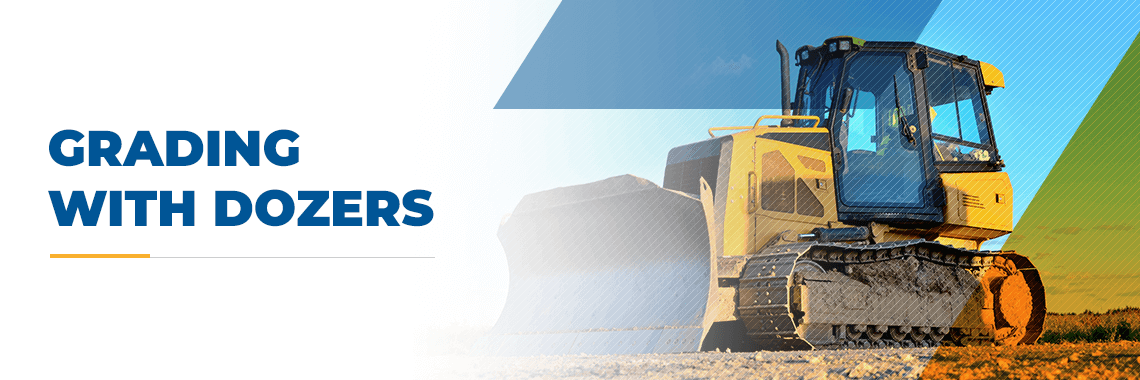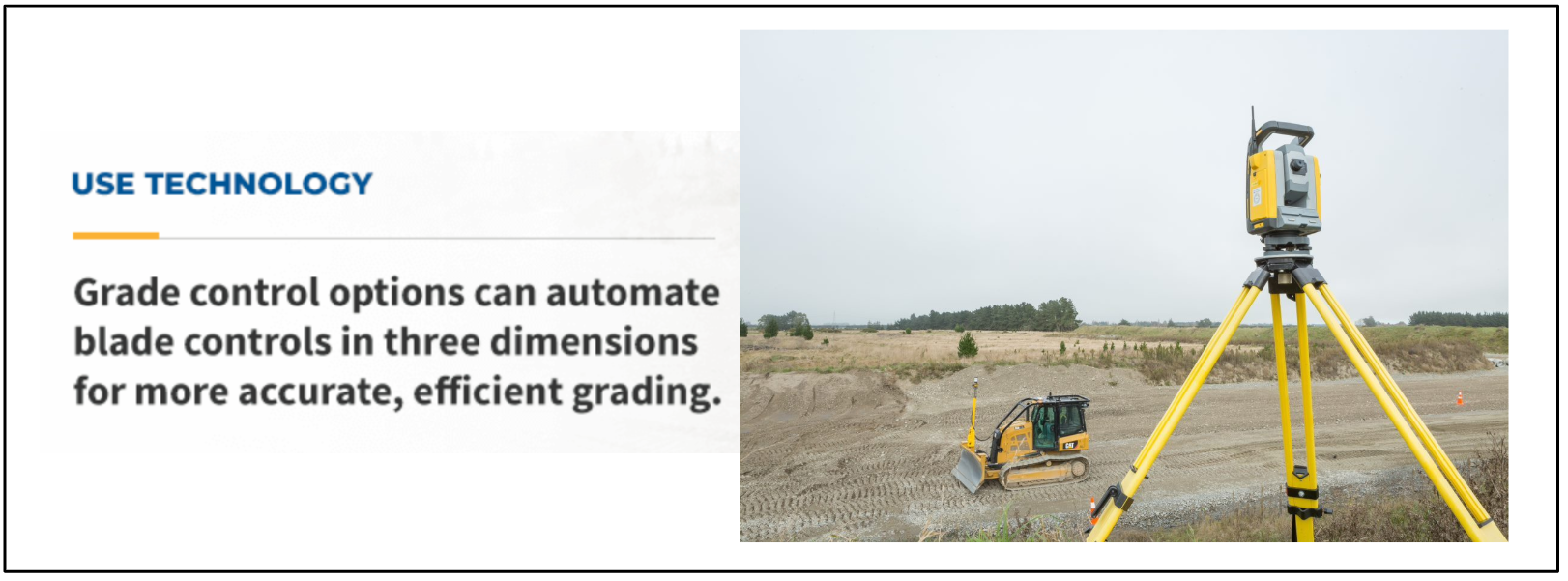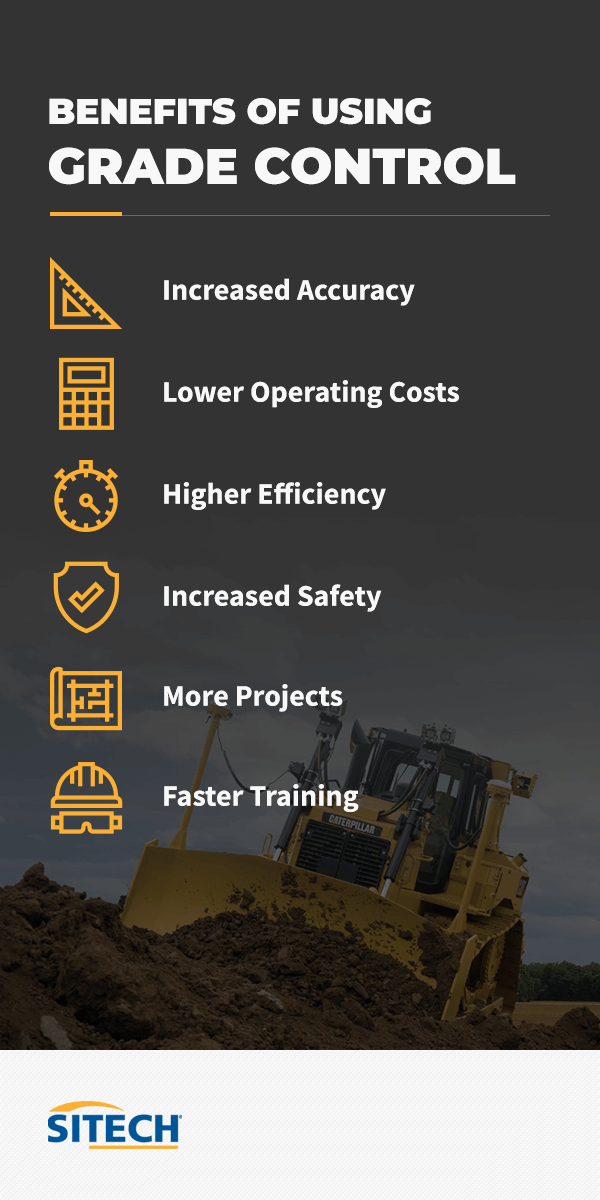
Knowing how to spread material with a dozer effectively can cut down on the time needed to complete construction projects. Mistakes made during land grading can set back jobs, costing the contractor and everyone on the construction team money. By using these tips and the right tools, you can learn to grade land correctly and efficiently and save time on building projects that require grading or spreading material.
JUMP TO SECTION
How Do Bulldozers Grade Land?
Bulldozers use a blade to move earth, which can help with flattening land for roadways or construction sites. In the late 19th century, railroad companies first used bulldozers to prepare the ground for rail lines. These early bulldozers got their name from the pair of bulls that provided the power. A massive, flat blade behind the draft animals scraped the land. A driver rode on a two-wheeled caisson attached by an arm to the blade.
Tracked vehicles came into use to replace pack animals for driving tractors. However, tractors with blades would not have this track added to them until 1921. This early 20th-century innovation of putting both a motor and track onto the previous versions of bulldozers paved the way for future upgrades to the dozer. However, these early dozers could not move the blade vertically — but that would change in 1928.
By 1928, bulldozers got a cable and winch upgrade, which allowed the blade to move vertically as it pushed horizontally over the land. After the Second World War, dozers upgraded again to more closely resemble the devices used today by integrating hydraulic control of the blade.
Due to the extensive use of dozers and other equipment for grading during the 1930s and 1940s, engineers learned how to most effectively outline the best practices for leveling land by using gravity.
A dozer works by pushing land with a large blade at the front. As the machine moves forward, the base of the blade scoops up earth that it runs over, collecting it in the blade. The operator must control the blade to direct the soil to a collection location and prevent track slippage. While many learn these skills through experience, tools available to modern dozer operators make the job easier and more efficient.
Tips for Grading With Dozers
Regardless of your experience, you can always learn ways to cut down on your time and effort when grading land with a bulldozer. When it comes to leveling ground with a bulldozer, always keep these tips in mind for more efficient operation:
1. Make Short Cuts
Instead of dragging the dozer over a long strip of land, use shorter cuts through the earth instead. If the blade has too much soil in it, the excess will spill out from the sides, reducing the efficiency of the task. While making short cuts through the earth seems to increase the driving time, the higher efficiency reduces the need to go over a long track of land multiple times due to inefficient movement of soil.
2. Use Technology
Use technology to automate some tasks on the dozer to help with grading land. Grade control options can automate blade controls in three dimensions for more accurate, efficient grading. The technology of grade control improves the speed and accuracy of any grading project with a dozer. Installing this system allows a dozer to turn into a finishing tool. In some instances, the operator only needs a dozer with grade control technology to create the necessary land changes. By using only a dozer, you save time and reduce the need to have both a grader and dozer on site.
Instead of waiting years for operators to gain the experience to become experts at land grading manually, use technology to give any operator an edge in productivity. New hires and seasoned workers can both benefit from the information provided by grade control and other technological innovations available for land grading.

3. Keep an Eye on the Track Tension
Keeping the tracks on your dozer too tight will not help prevent slippage. In fact, if the tracks have too much tension, they will wear out prematurely — up to three times faster than correctly tightened tracks. Always tighten the track per the manufacturer’s guidelines. Also, do not adjust the tension after cleaning the track. As mud and dirt from the worksite get into the track, the tension will increase.
4. Use the Slot Sides to Increase Blade Capacity
When creating a slot in the earth, start at a position two vehicle lengths back from where you want the slot to start. Move forward to the slot’s start and push the soil in the blade into a pile at the end of the pass. The starting location for the slot will have a space for the dirt collected from digging out the space.
Make a second pass over the same area but start four vehicle lengths back from the pile of accumulated earth. Continue moving over the same area, increasing the distance of the slot by two tractor lengths until you have created the necessary extent of the slot. This method ensures that already leveled land stays flat.
This method of working from the front to the back of the slot allows the sides of the slot to hold more earth in the blade. In some cases, you could increase the amount the blade can hold by up to 30%.
Factors Affecting Bulldozer Grading Accuracy
Multiple factors can influence accuracy when grading with a dozer.
Terrain
Bulldozers have a significant advantage over many other equipment types when traversing all types of terrain. Their tracks keep them from sinking in muddy or sandy ground and their wide bodies distribute their weight over a larger area, decreasing the machine’s ground pressure. The absence of tires also eliminates most grading issues resulting from inconsistent ground pressure.
However, especially rugged terrain can negatively impact results in manual applications due to potential grade control issues.
Weather Conditions
Even high-performing ground-hugging equipment can lose traction on wet ground, which can adversely affect grading results. This issue is more prevalent on steeper grades where the dozer will have more difficulty climbing. Also, a mistake many operators make when operating a bulldozer in the rain is driving the machine too fast.
Operator Skill
Many operators are proficient at performing basic earthmoving and related tasks with a bulldozer, but accurate grading can be more challenging, especially with fine grading work. Training and experience will help most operators improve their grading precision. Utilizing advanced technologies will also likely have a substantial impact, as it removes much of the guesswork that often leads to costly errors.
Tips for Improving Accuracy
Several tips and techniques are available to help bulldozer operators improve grading results:
Adjust Blade Angles
Depending on the equipment, operators may have several blade angle options, and making slight or more significant adjustments can affect accuracy. The most common angles for grading are 30, 45 and 60 degrees.
A 30-degree angle typically works best for lighter grading projects because it enables a shallow approach and a fine finish with minimal soil removal. A 45-degree angle works well for general-purpose applications, such as rough grading, cutting undulations and filling in lower spots. Setting the blade at 60 degrees delivers the best results when scarifying and cutting into harder or heavier soils.
Monitor the Tracks
Track performance plays a significant role in accuracy with a bulldozer. Equipment technicians may overly tighten the tracks during preventive maintenance, believing that this step will improve grading performance. However, increasing the tension beyond the manufacturer’s recommendations can cause premature wear and impede the traction the machine requires to maximize accuracy.
Utilize Automated Control Options
While operators will get better at grading with training and practice, humans naturally have accuracy limitations. The weather and other external factors can also prevent optimal results. Installing an automated grade control system will improve performance by increasing measuring precision. This tool makes the process easier to implement and helps to minimize errors.
Adapt to Different Soil Types
The soil composition and texture at a job site can range from extremely coarse to very fine and everything in between. You can increase grading accuracy by ensuring you choose the right tools and equipment for the specific task. For example, if you’re working with heavier soil, you’ll likely need a bulkier bulldozer with more power capacity. You’ll also need to select the appropriate blade for the material.
Do Dozers Have GPS?
Skill behind the controls of a dozer helps get the job done, but you can also improve efficiency and accuracy through the use of GPS or grade control. Automatic grade control systems use the same type of hardware found in NASA equipment and aviation navigation. This hardware, called inertial measurement unit (IMU), uses information about the tractor and blade’s locations based on sensor data and extrapolates it into three-dimensional details. This 3D information helps to control the blade and tractor for more precise land grading.
By combining the GPS information with the IMU processing the data, the system is more accurate than either technology used alone. The IMU processing overcomes problems that once kept GPS technology out of construction equipment. Issues solved by modern grade control systems include lost signals and lagging data updates. Thanks to today’s grade control systems, the worries of past GPS use have disappeared, making the technology useful for creating the most accurate grading possible.
Benefits of a GPS-Enabled Bulldozer
Once, if you wanted to know how to grade with a bulldozer, you had to learn through experience. Knowing the feel of the correct load in the blade was how operators would use dozers to grade land in the past. While this process worked well for those with years of experience, new operators would frequently make mistakes when trying to level ground without assistance.
By integrating grade control technology onto the dozer, even new operators can successfully level terrain without having years of experience. Dozer grade control systems provide numerous benefits to the operators and the site supervisors. These advantages include greater accuracy, lower operating costs, better performance, faster job completion and enhanced safety on site.
1. Increased Accuracy
While grading using manual controls, feeling the soil and eyeing for completion works decently for some jobs, using grade control with GPS increases the accuracy significantly. Some of these systems can guide the operator to within 15 millimeters of the set grade, which is close to one-half inch. Achieving such accuracy over an entire project is difficult without technological assistance.
Seasoned veterans of using dozers can also improve their grading accuracy and efficiency. For new users, the GPS-enhanced grade control takes charge of many of the adjustments that once required ample experience to make. Combined with intuitive controls found on many new dozers, grade control makes the systems more comfortable to use, regardless of who sits at the controls.
By allowing quality grading from any operator, grade control systems can help contractors make the most of the personnel currently on the team. Instead of having to find someone with years of experience, a new hire can quickly gain mastery of the system and produce well-graded land.
2. Lower Operating Costs
By automating many components of the grading process, grade control systems put less wear on equipment. For instance, one company reports operators getting grading done in six passes with a grade control system compared to ten passes without the GPS-enabled aide.
Since dozers need fewer passes to achieve results, they sustain less wear on them. Putting fewer miles on equipment extends the time between required maintenance services. Needing fewer repairs or services on equipment can help the bottom line by minimizing operating costs, which raises the profit margin.
Another way that using grade control technology can help lower operating costs is through reduced fuel and paid worker time. If an operator makes a mistake when grading land, they must take additional time to fix the error. With technology assisting the process, they will more likely get the job done to the ideal grade the first time. Since workers don’t need extra time to fix their mistakes, and the machines don’t have to operate longer to make corrections, overhead costs drop.
3. Higher Efficiency
How does GPS help grading with a dozer? One answer is improved speed. As far back as ten years ago, companies were reporting time savings of 50% by using GPS-assisted grade controls for their projects. Of course, as time progresses, the technology can only improve, too.
Today’s systems offer intuitive controls that make learning operation faster. By continually updating the information to the operator about the grading, the worker needs fewer passes to finish the job with greater accuracy. With data measuring to five-hundredths of a foot, the system can help the operator to create surgically precise cuts.
Finishing jobs faster is always a benefit for those in construction, especially when bonuses entice the team to work more quickly. However, working faster without working smarter could cause mistakes along the way. Instead of making your site prone to time-wasting errors, use grade control systems to rapidly get the land movement your site needs in as little time as possible.
4. Increased Safety
For dozer users and those working around the equipment, safety should be at the forefront of your operation. By using a grade control system, you lower the chances of repairing mistakes or improperly directing the dozer.
Additionally, most grade control systems eliminate the need to have grade checkers install stakes along the grading area. When workers aren’t needed to install stakes and strings, there are fewer people in the area where the dozer operates.
5. More Projects
While merely having grade control systems on dozers will not automatically win you more bids, you will have the chance to put in bids for jobs that you would not have been qualified for otherwise. For instance, specs for many DOT road-building jobs require the grade to measure within one-tenth of a foot.
Without grade control software, such accuracy would be difficult to achieve. If you only relied on older grading methods instead of grade control, you would not be able to put in a bid for such a job. However, the improved accuracy you attain from having a grade control system for your dozer may make you qualified to bid for lucrative DOT or similar projects in your area.
6. Faster Training
When using grade control systems, you become less reliant on hiring dozer operators with decades of experience. With construction industry workforce shortages, you may need to find newer, greener people to operate your dozers.
Because the grade control system augments the operator’s actions, you can hire those with less experience, which tends to offer a greater pool of prospects. Even if you cannot find experienced operators, modern dozer controls with grade control systems make training faster. Relatively new hires can learn the operation of the dozer faster, allowing you to spend less time on training and more time focusing on the job.

Use Grade Control for Dozers From SITECH Southwest
By integrating grade control into your earth-moving projects you will require fewer passes and put less wear on your equipment. With less strain on your dozers, you will need maintenance services less frequently, saving your operation money while increasing the profit margin. Find out for yourself how grade control can make your equipment more efficient by looking at our options at SITECH Southwest. We offer a range of solutions for many construction projects, including leveling land.
To find out more about SITECH Southwest and our grade control options, contact us today.
